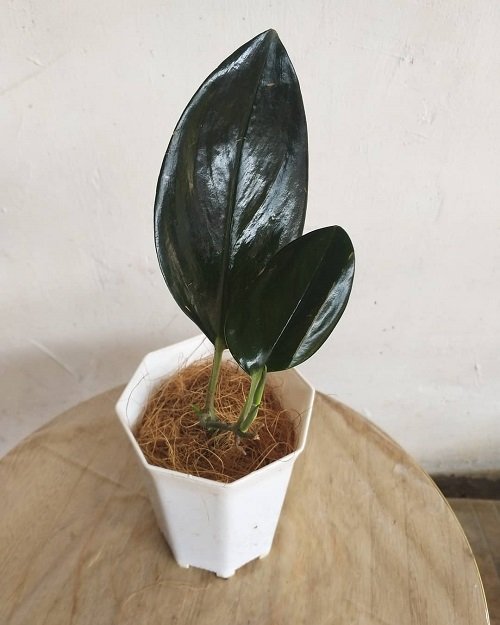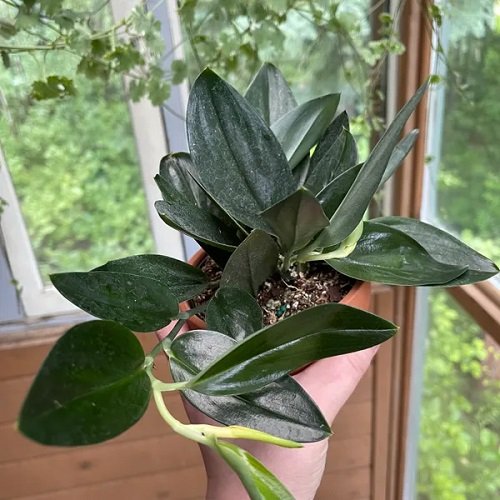Learn the art of Growing Black Pothos indoors, find out everything related to Scindapsus treubii ‘Dark Form’ in this post.
Black Pothos is a rare indoor plant that has captured the hearts of houseplant enthusiasts these days. Its unique and rich dark foliage sets it apart from the standard greenery, making it a prized addition to any indoor plant collection.
Propagating and Growing Pothos in Water
Black Pothos Plant Information
‘Dark Form,’ often called Black Pothos, is a variety of the Scindapsus treubii. Known for its velvety, deep green-to-black leaves, one thing to note is this plant is not a true pothos, nor is it as fast-growing as famous Epipremnum genus plants, but still, it’s worth growing if you’re a fan of foliage plants.
Native to Southeast Asia, the Scindapsus treubii species encompasses several varieties, but the ‘Dark Form’ stands out for its dramatic appearance and low-maintenance nature.
Origin
- Roots: Scindapsus treubii Dark Form originates from Southeast Asia, including countries like Malaysia, Thailand, and Indonesia. It’s a member of the Araceae family, known for its distinctive heart-shaped leaves and vining growth habit.
- Significance: Black Pothos holds significance as a popular houseplant due to its decorative leaves. Its rich, dark foliage adds a touch of elegance to indoor spaces. Its striking appearance has contributed to its growing popularity among plant enthusiasts and interior designers.
Flowers
The Scindapsus treubii Dark Form rarely blooms when grown as a houseplant, so its flowers are not something to discuss much. When it does flower, the blooms are typically small, inconspicuous, and usually have a creamy white to pale green color.
The plant is primarily valued for its unique dark foliage rather than its flowers.
How to Grow Different Pothos in One Pot | Best Pothos Combinations
Size
The size of a mature Scindapsus treubii, ‘Dark Form,’ or Black Pothos, can vary based on its growing conditions and care. In general, this slow-growing climber can grow fairly long if provided with appropriate support.
The leaves of the Scindapsus treubii Dark Form can reach around 2 to 4 inches in width and 6 to 10 inches in length. When allowed to climb or trail, the vines can travel several feet.
Black Pothos Display
The Black Pothos can bring a unique and captivating element to small spaces like balcony or patios and interior decor. Its dark, almost black leaves contrast sharply against lighter surroundings, making it a popular choice for adding depth and visual interest to living spaces, offices, and other indoor environments.
When used in interior design, the Scindapsus treubii Dark Form can be displayed in hanging baskets or placed on shelves where its trailing vines can cascade dramatically.
Propagating Scindapsus treubii Dark Form
Ways to Propagate Scindapsus treubii Dark Form
- Stem Cuttings
- Air Layering
- Division
- Water Propagation
Check out the Secret Tips to Grow Lush Pothos Plant here
The Most Popular and Reliable Method: Stem Cuttings
Stem cuttings are favored for their high success rate, genetic similarity to the parent plant, quick growth, simplicity, and minimal materials required, making this a reliable choice for propagating Scindapsus treubii Dark Form.
Steps to Grow Black Pothos from Stem Cuttings
- Select a Healthy Cutting: Choose a healthy stem with at least one leaf node from your Black Pothos plant.
- Cut the Stem: Make a clean cut just below a leaf node using clean scissors or pruning shears.
- Remove Lower Leaves: Trim or remove the leaves near the cut end, leaving a few leaves at the top for photosynthesis.
- Choose a Suitable Container: Place the Scindapsus treubii Dark Form cutting in a small container with a well-draining potting mix or try a glass of water if you’re opting for water propagation.
- Provide Indirect Light: Place the container in a location with bright, indirect light. Avoid direct sunlight that can scorch the cutting.
- Maintain Humidity: Cover the Scindapsus treubii Dark Form cutting with a clear plastic bag or place it in a clear plastic container to create a humid microenvironment.
- Keep Soil Moist or Water Changed: If using soil, keep the potting mix consistently moist but not soggy. For water propagation, change the water every few days.
- Monitor and Wait for Roots: Check for root growth in a few weeks to a couple of months, varying based on conditions and environment.
- Transplant to a Pot: Once the cutting has developed several inches of roots, carefully transplant it into a suitable indoor pot with well-draining soil.
Why It’s Best to Grow from Cuttings
- High Success Rate: Stem cuttings generally have a high success rate because they involve taking a portion of the plant that already has the potential to develop roots and grow into a new plant.
- Genetic Similarity: When you propagate through stem cuttings, the new plant is similar to the parent plant. This ensures that you’re getting a clone of the original plant, which is important if you want to maintain specific characteristics of the Scindapsus treubii Dark Form, such as its dark foliage or the size of the leaves.
- Speed of Growth: Once the cutting develops roots and establishes itself, it can grow more quickly compared to some other propagation methods listed above.
Choosing a Container for Black Pothos

When selecting a container for growing Black Pothos indoors, it’s important to consider the pot size and material for optimal growth. A pot with a 4 to 6 inches diameter is generally suitable for a young plant. It’s a bad idea to grow a houseplant in an overly large pot.
As the plant grows, you can gradually move it into larger pots to accommodate its root system.
Also, choosing a container with drainage holes is crucial to prevent overwatering and root rot. Terra cotta pots are a good choice as they allow for better airflow and moisture regulation, but any well-draining pot made from materials like plastic or ceramic can work well. Ultimately, what matters is your choice and what goes well with your interior.
Plant Pot Sizes from Inches to Gallon
Requirements for Growing Black Pothos
Sunlight
- Intensity: Black Pothos thrives in moderate to bright indirect light. Avoid exposing it to intense, direct sunlight, as it can scorch the leaves. Filtered or dappled sunlight is ideal for maintaining the plant’s vibrant foliage.
- Location: Place your Scindapsus treubii Dark Form in a location that receives ample indirect light. Ideal spots include near the East-facing window or slightly away from the West or South facing window, where the plant can benefit from gentle morning or filtered afternoon sunlight.
Note: If direct sunlight is unavoidable, ensure it’s diffused through a sheer curtain or placed a few feet away from the window to prevent leaf damage.
Soil
- Type: Black Pothos thrives in well-draining soil. A mix of potting soil with good drainage properties, such as a blend of regular indoor potting mix and perlite or coarse sand or orchid bark – works well. This helps prevent waterlogging and promotes healthy root growth.
- pH Level: Maintain a slightly acidic to neutral pH level for the soil, ideally around 6.0 to 7.5. This pH range supports nutrient availability and overall plant health. Regular monitoring of the soil’s pH can help ensure optimal conditions for your Black Pothos to flourish indoors.
Stunning Ways to Display Pothos in Home
Water
- Frequency: Water your Black Pothos when the top inch of the soil feels slightly dry to the touch. Allow the soil to dry out between waterings, but avoid letting it become overly dry.
- Method: Water your Black Pothos thoroughly, ensuring water reaches the root zone. Allow excess water to drain from the pot’s bottom. Avoid leaving the plant pot sitting on standing water of the saucer, as this can lead to root issues. You can also water from the top, but take care not to wet the foliage often.
Note: Overwatering can lead to root rot, so it’s better to slightly underwater than overwater this plant.
Temperature
- Range: Black Pothos thrives in average indoor temperatures. It prefers a temperature range of around 60°F to 85°F (15°C to 29°C) during the day. Being pothos, it can tolerate lower and higher temperatures efficiently, but it would be better to avoid exposing it to extreme temperature fluctuations and drafts, as sudden temperature changes can stress the plant.
- Protection: Protect your Scindapsus treubii Dark Form from cold drafts and sudden temperature drops, especially during the winter months. Keep it away from heaters, air conditioning units, and windows that might become too cold during the night.
Providing stable and consistent temperatures within its preferred range will contribute to its overall health and well-being.
Here are Different Ways to Grow Pothos in Home & Garden
Black Pothos Care

Fertilizer
- Frequency: Fertilize your Black Pothos once every 5 to 7 weeks during the growing season, typically spanning from spring through early fall. Reduce or suspend fertilization in colder months when the plant’s growth slows down. However, if you live in a warm climate, you can feed your plant year-round.
Note: We are recommending this frequency because it is a slow-growing plant and doesn’t require frequent feeding.
- Type of Fertilizer: Opt for a balanced, water-soluble fertilizer with a ratio of 10-10-10 or 20-20-20. Alternatively, specialized indoor plant fertilizers work well. Make sure the fertilizer includes essential nutrients like nitrogen, phosphorus, potassium, and micronutrients.
- Application: Dilute the fertilizer to a quarter to half (1/4 to 1/2) of the recommended strength, following the instructions on the package. Apply when the soil is already damp to prevent root stress.
Note: Overfertilization can harm the plant, so err on the side of caution. If using slow-release pellets, adhere to the package guidelines and water the plant afterward.
Pruning
Prune is not much required for your Black Pothos. But removal of yellowing or damaged leaves promptly can improve the overall appearance of the plant and prevents any potential spread of disease.
Pruning can be done throughout the year, but it’s often best done in spring or early summer when the plant’s growth is most active.
How Cold Can Pothos Tolerate | Pothos Cold Tolerance
Pests
- Mealybugs: Small, cottony insects that cluster on leaves and stems, causing damage by sucking plant sap and secreting honeydew, leading to mold growth.
- Spider Mites: Tiny pests that create fine webbing on leaves, causing stippling, discoloration, and weakening of the plant.
- Scale Insects: Small, immobile insects that attach to leaves and stems, feeding on plant sap and causing yellowing, stunted growth, and sooty mold.
- Whiteflies: Tiny, white insects that fly around when disturbed and feed on plant sap, causing leaf yellowing, wilting, and the spread of viruses.
Diseases
- Root Rot: Fungal infection caused by overwatering and poor drainage, leading to wilting, yellowing, and decay of roots.
- Leaf Spot: Fungal or bacterial infections leading to brown or black spots on leaves, often due to excess moisture.
- Anthracnose: Fungal disease causing small, sunken lesions on leaves, which eventually expand and become necrotic.
- Powdery Mildew: Fungal growth on leaves, resulting in powdery white spots that weaken the plant and hinder photosynthesis.
- Downy Mildew: Fungal infection causing yellow patches on leaves and the development of grayish fungal growth on the undersides.
Scindapsus treubii Dark Form – FAQs
1. Can I Grow Scindapsus treubii Dark Form Outdoors?
Yes, you can grow Black Pothos outdoors in areas with suitable climate conditions. Provide filtered light, well-draining soil, and protect it from harsh direct sunlight and extreme temperatures. Be aware of outdoor pests and diseases that may affect the plant.
2. Is Black Pothos Toxic to Pets?
Yes, Black Pothos is considered toxic to pets if ingested. The plant contains calcium oxalate crystals, which can cause irritation and discomfort if consumed. Keep it out of reach of curious pets to ensure their safety.
3. Does Black Pothos Require High Humidity?
While Black Pothos appreciates moderate to high humidity, it can tolerate average indoor humidity levels. To enhance its growth and appearance, consider misting the leaves occasionally or placing a humidity tray nearby.
Find If Humidity is Good for Pothos here
4. How Fast Does Black Pothos Grow?
Black Pothos has a moderate growth rate, especially when provided with optimal care conditions. Its growth rate can be influenced by factors such as light, temperature, humidity, and fertilization.
5. How Do I Revive a Wilting Scindapsus treubii Dark Form?
If your Black Pothos is wilting, check the soil moisture and adjust your watering frequency if needed. Trim any severely wilted or yellowing leaves, and consider providing a more suitable light and humidity environment.






